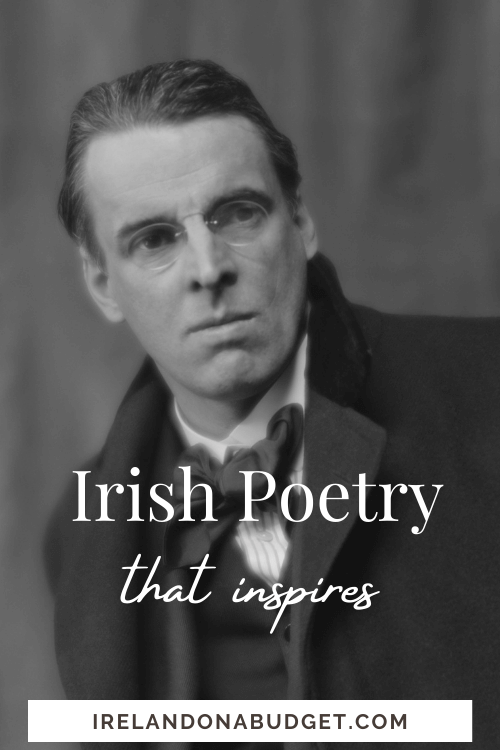Ireland is well known for being the land of “saints and scholars” and among those acclaimed scholars you’ll find writers of short stories, novels, and poems.
 This post and page contain affiliate links and I may earn compensation when you click on the links at no additional cost to you.
This post and page contain affiliate links and I may earn compensation when you click on the links at no additional cost to you.
While generally more packed with meaning than prose, Irish poems illustrate the beauty and soul of Ireland that perhaps no other medium can do.
Here are 3 Irish poets who do just that.
Patrick Kavanagh
While Patrick Kavanagh was born in rural Co. Monaghan, much of his life was spent away from the land-locked county, which is the smallest in the province of Ulster.
However, that didn’t quell the love he had for his county. In fact, much of his work was inspired by it.

In his poem, “The One,” Kavanagh writes about seeing the beauty of the ordinary places of home, which was Inniskeen.
In writing this particular poem, it brought him back to the boglands surrounding it, a place that he hated while growing up but eventually came to love.
By clicking on the Amazon link below, I may earn a small commission from the Amazon Associates Program. However, you will not incur any additional costs by doing so.
Read A Poet's Country: Patrick Kavanagh Selected Prose on Amazon
The One
Green, blue, yellow, and red –
God is down in the swamps and marshes
Sensational as April and almost incredible
the flowering of our catharsis.
A humble scene in a backward place
Where no one important ever looked
The raving flowers looked up in the face
Of the One and the Endless, the Mind that has baulked
The profoundest of mortals. A primrose, a violet,
A violent wild iris – but mostly anonymous performers
Yet an important occasion as the Muse at her toilet
Prepared to inform the local farmers
That beautiful, beautiful, beautiful God
Was breathing His love by a cut-away bog.
Learn More About Patrick Kavanagh
The perfect introduction to Kavanagh and his writing is through the Patrick Kavanagh Centre, a place that commemorates the poet and his work.
The center includes exhibitions outlining his life story as well as a history of the surrounding area.

Kavanagh was born in 1903, the fourth of 10 children. He left primary school at age 13 to help his father, a cobbler.
Kavanagh also worked on his family’s farm as a young boy.
You’ll get a much better feel for the local area and the places that influenced Kavanagh by taking a tour of Kavanagh Country, which is organized by the center.

The tour takes in many local sites, including the Patrick Kavanagh Literary & Resource Centre, the ruins of the Norman Notte & Augustinian Monastery, the Folk Museum and Round Tower, Billy Brennan’s Barn, the Kednaminsha National School, Cassidy’s Hanging Hill, and The Kavanagh Homestead, all places that influenced his writing.

Visitors to the center can also take the Kavanagh Trail, which begins there and makes its way through the village, down lanes, and over fields of this understated county filled with drumlins and quiet country roads.
Kavanagh died on Nov. 30, 1967, of pneumonia in a Dublin nursing home. There are other commemorations to Kavanagh besides the County Monaghan center.

They include a sculpture of Kavanagh sitting on a bench by the Grand Canal, a place where he spent a lot of time in his later years, and a wax figure at the National Wax Museum in Dublin.
Read More: 8 Irish Writer Attractions to Explore
William Butler Yeats
County Sligo is closely associated with William Butler Yeats, who wasn’t born in Sligo, but his mother, Susan Pollefexen was, and so he had close connections to the county.
When he was 7, the family relocated to Sligo and Yeats lived in the Pollexfen family home for two years.
This was the beginning of his lifelong obsession with Sligo, a place he once called his “country of the heart.”

In his poem, “The Lake Isle of Innisfree,” Yeats expresses his desire for peace and tranquility away from the noise of London, where he first got the idea for the 12-line poem.
Read More: 4 Irish Fairy Tales that Make for Some Captivating Stories
The Lake Isle of Innisfree
I will arise and go now, and go to Innisfree,
And a small cabin build there, of clay and wattles made;
Nine bean-rows will I have there, a hive for the honey-bee,
And live alone in the bee-loud glade.
And I shall have some peace there, for peace comes dropping slow,
Dropping from the veils of the morning to where the cricket sings;
There, midnight’s all a glimmer, and noon a purple glow,
And evening full of the linnet’s wings.
I will arise and go now, for always night and day
I hear lake water lapping with low sounds by the shore;
While I stand on the roadway, or on the pavements grey,
I hear it in the deep heart’s core.
Learn More About William Butler Yeats
The Yeats Society located in Sligo town is where you’ll discover more about the famous poet.
The Society, which is located in The Yeats Building at Hyde Bridge in the center of town, offers a variety of tours, including a group tour that takes participants to the top of Knocknarea where Yeats’s poetry is read and the story of Yeats and Sligo is told.

A walking tour of Sligo is also offered by the Society that starts with a look at its indoor Yeats exhibition, which includes artifacts related to the poet, such as Lily’s writing desk, which was presumably in the family home and used by his sister, Lily.

Part of the exhibition also includes a previously unseen color film of Yeats’s funeral in Sligo, with dignitaries like Eamon de Valera in attendance and others.
The walking tour covers all of the places in Sligo associated with the Yeats family.
By clicking on the Amazon link below, I may earn a small commission from the Amazon Associates Program. However, you will not incur any additional costs by doing so.
Read The Collected Poetry of William Butler Yeats
Seamus Heaney
Like Kavanagh, Seamus Heaney’s poetry was also a reflection of where he grew up in Bellaghy, Co. Derry.
Similar to Kavanagh, he, too wrote about the ordinary things in life, which is abundantly clear in his poem, “Digging.”
The poem, published in 1966, is about his family’s traditions on their farm and explains the importance of respect and hard work.
You'll find the beautiful words to this poem below, or you might like to hear Irish actor Liam Neeson recite a few in this Discover Ireland video that recounts Heaney's poetry and the beautiful places that inspired him.
Digging
Between my finger and my thumb
The squat pen rests; snug as a gun
Under my window, a clean rasping sound
When the spade sinks into gravelly ground:
My father, digging. I look down
Till his straining rump among the flowerbeds
Bends low, comes up twenty years away
Stooping in rhythm through potato drills
Where he was digging.
The coarse boot nestled on the lug, the shaft
Against the inside knee was levered firmly.
He rooted out tall tops, buried the bright edge deep
To scatter new potatoes that we picked,
Loving their cool hardness in our hands.
By God, the old man could handle a spade.
Just like his old man.
My grandfather cut more turf in a day
Than any other man on Toner’s bog.
Once I carried him milk in a bottle
Corked sloppily with paper. He straightened up
To drink it, then fell to right away
Nicking and slicing neatly, heaving sods
Over his shoulder, going down and down|
For the good turf. Digging.
The cold smell of potato mould, the squelch and slap
Of soggy peat, the curt cuts of an edge
Through living roots awaken in my head.
But I’ve no spade to follow men like them.
Between my finger and my thumb
The squat pen rests.
I’ll dig with it.
Learn More About Seamus Heaney
There’s a wealth of information about Heaney and his life’s work at the Seamus Heaney HomePlace, Northern Ireland’s tribute to its native son and Nobel Prize winner.
The center is housed in a building transformed from an old, heavily fortified RUC police station.

Over two floors, you’ll find many of Heaney’s books and personal belongings, in addition to a recreation of the attic study from his house in Dublin.
There is also a creative zone where you can put your own creations or ideas on paper inspired by Heaney’s work of course.

There are video recordings from friends, neighbors, and cultural leaders, and the voice of the poet himself reading his own work.
To get a true sense of what influenced Heaney you need to head further into the surrounding countryside.
Taking a tour with local man Eugene Kielt, a veritable Heaney expert and owner of the popular Laurel Villa, is a must if you're a Heaney fan.

The Heaney aficionado takes individuals and group tours to various sites in this part of Ulster and to places where Heaney lived and experienced life.
Those places include the Old Market Yard in Magherafelt, where a local man sold rope, inspiring the poem, “Seeing Things XVIII;” at Mossbawn farmhouse, where Heaney was born; the Gaelic football grounds where his uncle played for a Derry inter-county team, and much more.

Kielt’s guest house, a Victorian-style building, is a treasure trove of poetry books and art dedicated to the poet. The dining room alone is a shrine to Heaney, with framed reproductions of his poetry on the walls.
In fact, Heaney once read one of his poems in this very room.
By clicking on the Amazon link below, I may earn a small commission from the Amazon Associates Program. However, you will not incur any additional costs by doing so.
Read: 100 Poems by Seamus Heaney
Are you a fan of Irish poetry? Have you read any of the works of the 3 Irish poets mentioned above? Let me know in the comments below.




